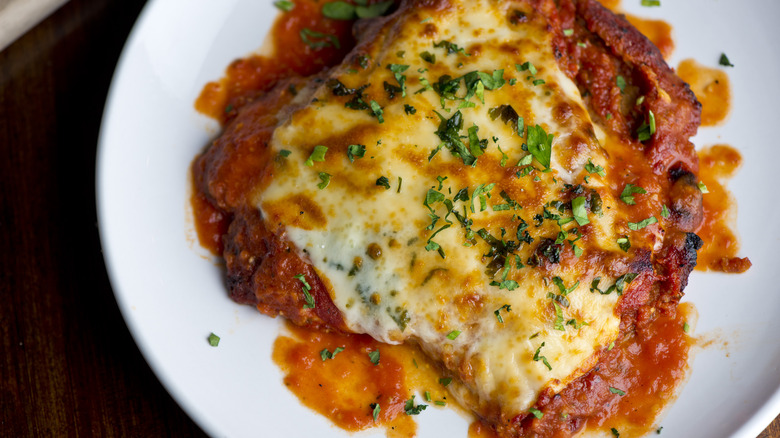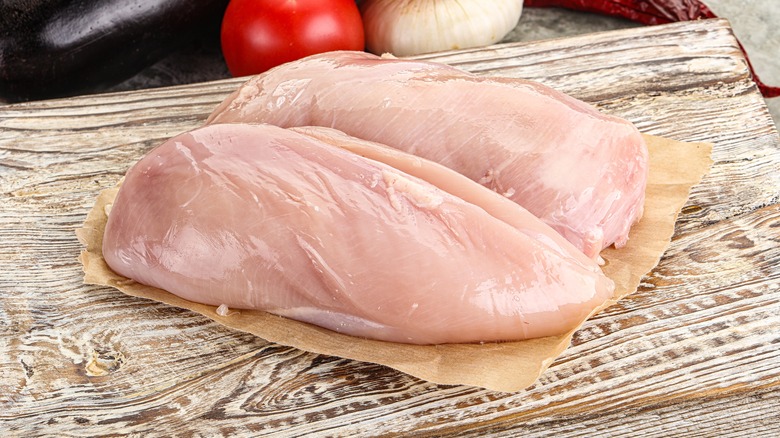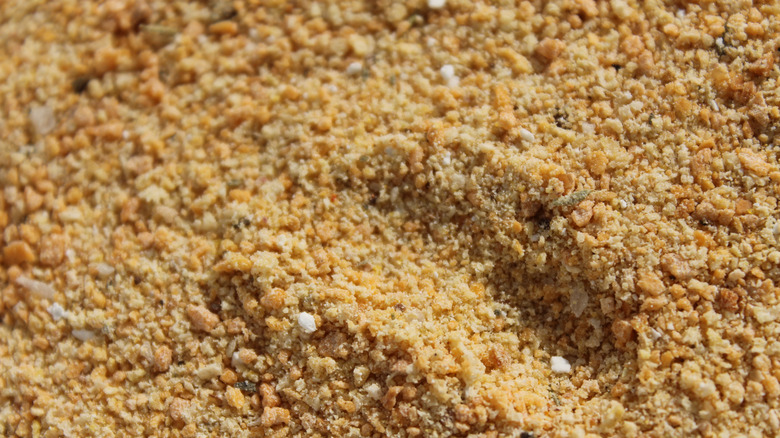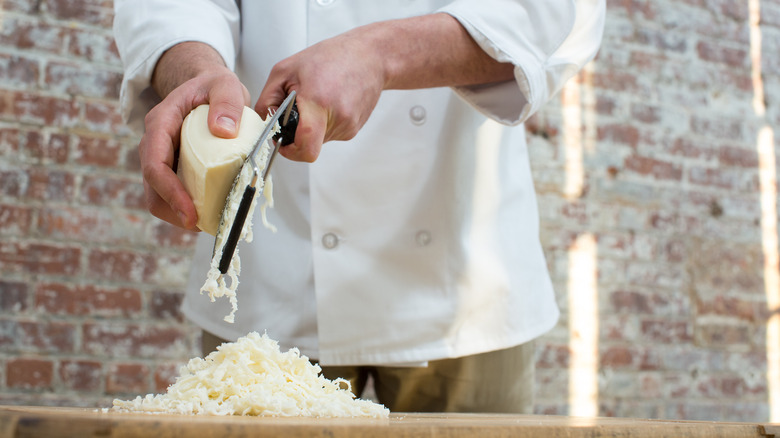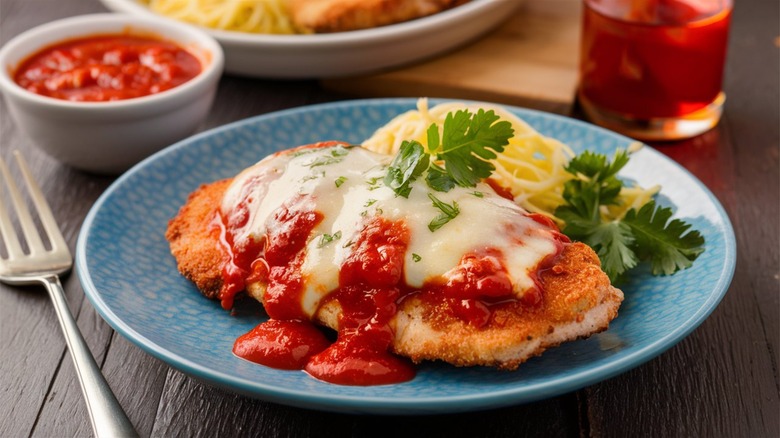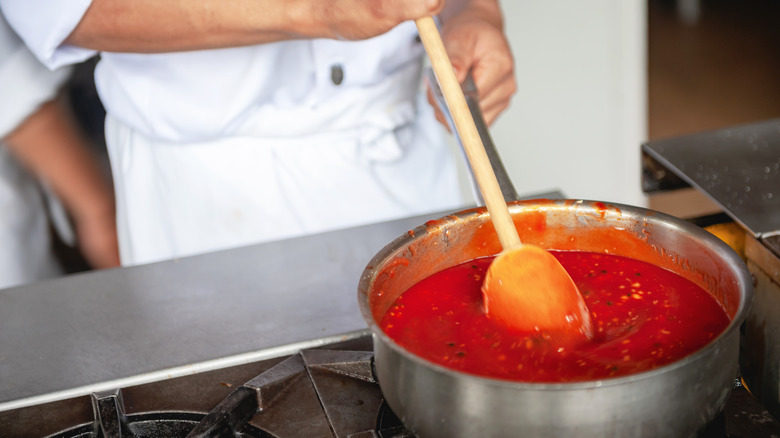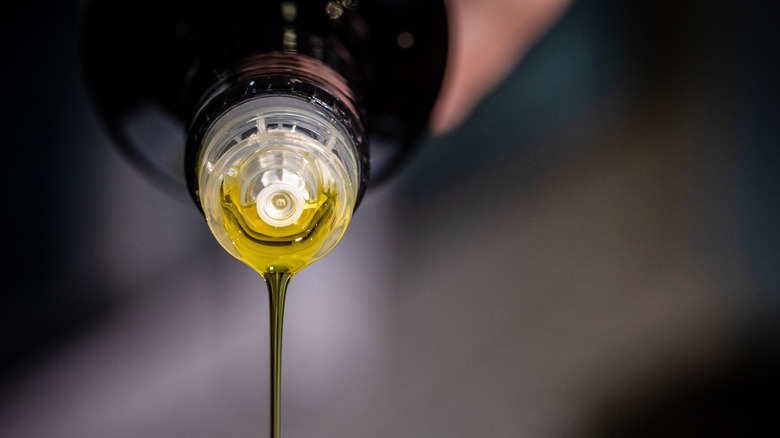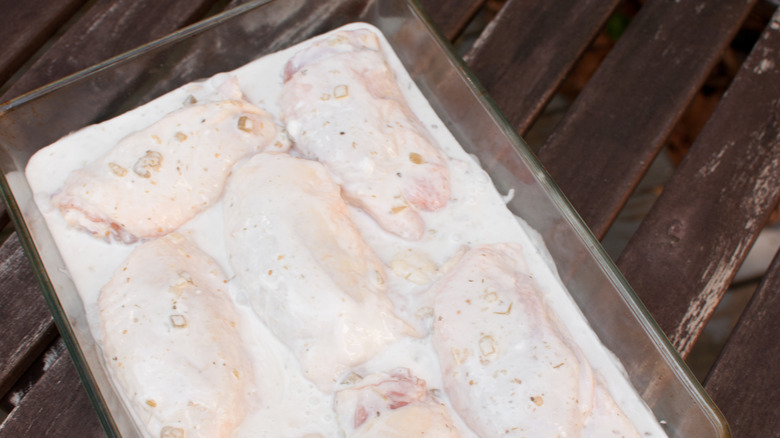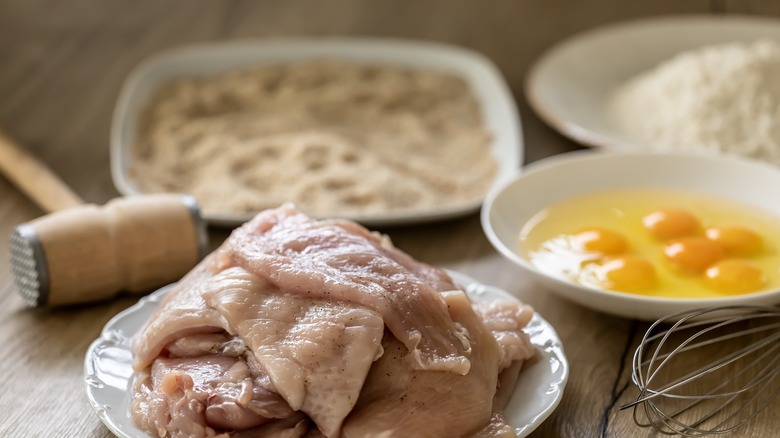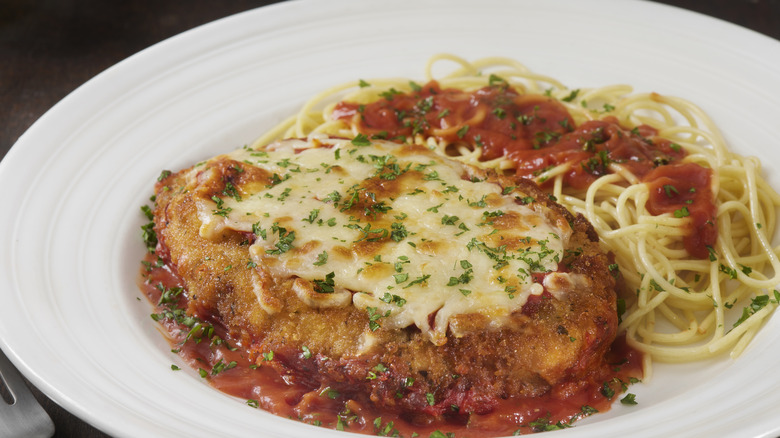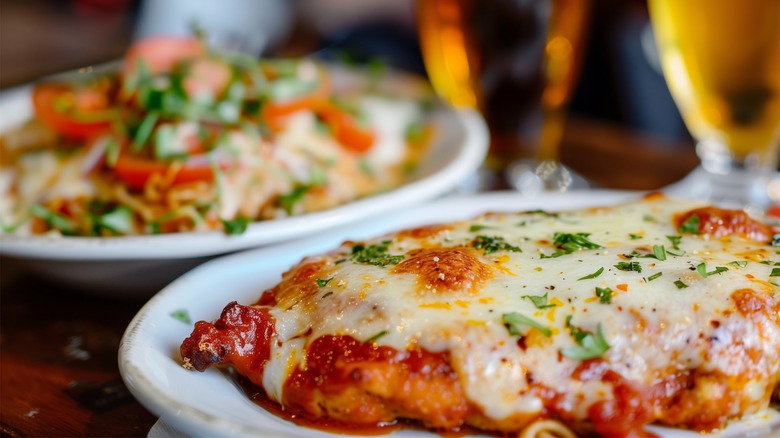We Spoke To Chefs To Find Out Why Chicken Parmesan Always Tastes Better At A Restaurant
There are scores of breaded cutlets that exist in the range of Americanized Italian cuisine. And the typical kind your average trattoria plates for customers, if it isn't eggplant or veal, is chicken. Dining out when a classic chicken Parmesan is on the table makes life worth living — a life where the gooiest cheese pull, an herby tomato sauce, and a crackled breadcrumb coating coalesce perfectly around moist chicken breast. But creating a fabulous meal comes easy for the professional red sauce parlor. For amateurs (and that's not a bad thing!), we run the risk of splattering our Little Italy fantasies with chewy chicken or a soggy batter. Chicken Parmesan is tricky; attempting it from scratch is even trickier.
For creating a restaurant-worthy dish, it's definitely in one's best interest to call upon a professional for help. And whose expertise, other than an elite restaurateur, will help hone those culinary chops? If you are committed to recreating this comfort food, allow chef Brandon Boudet of Little Dom's in Los Angeles, owner Emilio Perna Ruggiero of Parma Trattoria & Mozzarella Bar in Louisville, Colorado, and chef Chris Curtiss of the dining chain North Italia to share their techniques, as well as offer corrections to boost your Parm to the next level. And good news for readers, the process is easy, says Chris Curtiss: "I am confident that if they use these simple recommendations, they will be very pleased with the end results."
Properly tenderizing the chicken
To prepare a chicken Parmesan in line with the iconic Italian eateries, you've got to start by pounding out the poultry. As chef Chris Curtiss points to using his own kitchen as an example, "We flatten and tenderize the chicken breasts so that when they are cooked, the chicken cooks evenly, and it is very tender!" How flat are we talking, here? The solution isn't to Hulk-smash the pieces into a skimpy rag so your breadcrumbs won't cling to the chicken, and when you set to frying your cutlets, the meat inside will be bone-dry, not juicy. Instead, simply hammer down the chicken with your instrument (cooks have been found to use a pounding mallet or rolling pin at this juncture) which will ensure your cutlets maintain a uniform thickness.
Cutting out this part of the process is to be expected with modified versions — an easy weeknight recipe offers a pleasant respite from this extra labor, which can be a hassle when all you want to do is devour it whole. However, should one's goal be to construct a plate worthy of the Michelin star, you'll want to guarantee your chicken breast is perfectly cooked while simultaneously retaining a moist, toothsome flavor. Take notes from the professionals, then, and get to punching — you'll thank us later. "You want a nice, evenly pounded (but not too thin) chicken breast," adds chef Brandon Boudet of Little Dom's.
Chefs season the breadcrumbs themselves
When the time comes for preparing the breadcrumbs, you don't have to bake a loaf yourself (though eateries like NYC's Carbone do this bit regularly). It's totally acceptable to buy them from the supermarket. However, just steer clear of the varieties that come pre-seasoned. Breadcrumbs manufactured with the spices included are harder to adjust since you're stuck with whatever proportions are mixed into the container. The flavor may be stale or muted, robbing your coating of the vibrancy you get from freshly-shaken herbs. That's why applying the seasoning with your own two hands will lend your chicken Parmesan a more authentic flair in tune with professional chefs.
Brandon Boudet advises home cooks to "instead use a classic, plain breadcrumb and season it yourself so you can achieve a fresher, cleaner flavor." His personal go-to blend favors Italian-style herbs such as oregano and parsley, but likes to pair it with sharper notes found in grated Parmesan and lemon zest. Chris Curtiss, on the other hand, is a fan of panko breadcrumbs for his coating, but cuts it with a "three to one ratio" of shredded Parmigiano-Reggiano dashed with thyme and dried oregano. At Emilio Perna Ruggiero's establishment (decreed a "Best of Boulder" winner in 2023) the eatery similarly springs for the Japanese-style crumbs and infuses it with an undisclosed spice blend.
They blend different cheeses together
Cheese is the glue behind every chicken Parmesan on the planet; it's basically non-negotiable. Stretching across the cutlet in a gooey, lightly-toasted blanket, mozzarella is the variety that comes most suggested in cookbooks and online recipes. Surprisingly, the pros seem much less concerned with tradition, as our sources professed to utilizing interesting blends in their renditions. We can't speak for every restaurant, but in the professional eateries we've canvassed, cooks aren't afraid to experiment with different cheeses for the topping. To grate a mix of cheeses draws out varying degrees of sharpness, saltiness, and textural flair; it gives simple recipes a boost of complexity.
Under Brandon Boudet's watch at Little Dom's, hard Italian cheeses mingle with softer counterparts. As he reveals, "We use a mixture of aged provolone, fresh mozzarella, and Grana Padano or Parmigiano-Reggiano." Alternately, Chris Curtiss enjoys rotating between provolone, mozzarella, and fontina. Good mozza on its own is always a supreme choice, since Parma Trattoria & Mozzarella Bar, true to the name, layers its parmigiana with a low-moisture version and nothing more.
There's nothing wrong with sticking to the default. But at upscale dining rooms, experimenting with various combos happens more frequently than you think. You might find that specialty shops, or even the import section of your supermarket's cheese counter, holds the answer for a transcendent Parmesan.
Restaurants don't overdo the sauce
Tomato sauce is delicious, and a good chicken Parmesan knows how to put it to use. But you don't want to add too much. Because you rely on the chicken's coating to stay intact, glopping it on causes it to soak into the crust, which turns the crunchy exterior mealy and mushy. As a result, you won't find many experts admitting to heavily drenching their cutlets: restraint is key amongst elite professionals. "Only top the chicken with a small layer of hot marinara then top with the cheese," instructs Chris Curtiss. Advice which certainly defies the comically-sloppy plates part and parcel of many restaurant chains.
Practically speaking, hand-breading and frying pieces of chicken takes a lot of labor. All that effort could be washed away pouring on the marinara, as tasty though it may be. From a pro's perspective, lightly spreading the sauce brings out the satisfying mouthfeel, without sacrificing your efforts. This approach is one that Brandon Boudet and Emilio Perna Ruggiero abide by as well, particularly for Boudet. In describing his technique, he aims to make the sauce a complementary element to the chicken."We add a small amount of sauce to the bottom of the plate and then cover about a third or half of the chicken with sauce so that it's not drowning," he says. A light saucing hand not only imbues elegance to your plate; it varies up the textural sensations you receive in every morsel.
For a bolder sauce, stir in some cheese
About that sauce? There's an ingredient you might be sleeping on that world-class dining establishments embrace when firing up the stove: cheese. Preparing the menu item at Little Dom's involves spiking the sauce with the shreds left over from assembling the garnish, and per chef Brandon Boudet, it's a useful trick to leveling up the consistency and character. "We add and whisk in some of the cheese that's used on top of the chicken to the sauce mixture, which adds a little richness to it," he says, elaborating on how a small dose makes a big difference. "You don't have to add a lot — just enough to add some fat and body to the sauce."
From a practical standpoint, stirring cheese into the sauce is a great flavor-enhancing tactic. You'll find that the same sharp, salty notes of the cheese topping swirl throughout the marinara, infusing every bite that isn't just the cheese that's crusted on. And due to the presence of fats mingling together with the starchy breadcrumbs, the cheese takes on the role as a thickening agent, further emulsifying the mixture.
Marinara sauce is just one element to chicken Parm, but it's an important one. It's clear that cheese (or most dairy, really) is the answer to amplifying the flavor, and packing a bold blast is what takes a scratch-made rendition to the halls of fame.
They cook with olive oil
When it comes to chicken Parmesan, the right oil for the job will lend good texture and a golden hue to your main course. You can count on many Italian joints to sizzle olive oil, thanks to a decent smoke point for frying and its general versatility. "I'd recommend using a neutral olive oil like Palmer's," Brandon Boudet reveals, since the oil possesses a faint essence that won't detract from the herbaceous, savory chicken breast. "You don't want anything flavored. Alternative oils like avocado oil isn't the best for sautéing."
Likewise, New York restaurateur Mario Carbone is also a proponent of this variety, but believes in vying for a premium bottle to elevate the quality. "I try not to skimp on the olive oil even when cooking," he explains in a video created for his dining concept Carbone Fine Food, elaborating on the role the oil can play in affecting the flavorsomeness of your dish. "Moral of the story, don't be cheap with the grease," he concludes.
Sautéing some chicken breasts for yourself (or loved ones) won't command the same amount of grease as a full-sized dining operation. Granted that Chris Curtiss manages almost 40 dining spaces under the North Italia banner, his advice for home cooks will be tailored with these circumstances in mind. "If you are cooking just a few pieces of chicken Parmesan, I would recommend using extra-virgin olive oil," he says.
Buttermilk brining can elevate the tenderness of your chicken
Even with the golden-browned coating, we'd argue that Chicken Parmesan isn't much akin to the bucket of fried chicken hawked out of drive-thrus. Nevertheless, the process of readying your fillets for frying may benefit from a process reserved for Southern poultry, something that may surprise fans of the Italian comfort food: using buttermilk. Buttermilk brining can increase the tenderness of your chicken. Thanks to the live cultures and acids the dairy byproduct produces, your meat will foster a juicy, succulent profile. Those rich fats in the buttermilk also help the breadcrumbs stick, which, as we all know, is absolutely necessary for any piece of chicken you plan on searing in oil.
Understandably, amateurs are probably intimidated by this step. But if you have leftover buttermilk in your fridge anyway, the choice to marinade comes recommended, given that it ensures the chicken's moisture is locked in — and bonus, the intensified flavor resulting from the buttermilk's sour disposition. Little Dom's Brandon Boudet is one who swears by this tip, elaborating on how his Los Feliz spot has integrated it as a matter of routine. And, assuming you're expecting that the meat steeps for a whole day, the head chef claims it's a much more manageable wait time: "We let the chicken breast brine for about one to two hours before we bread and fry it," he says.
They stick to a foolproof breading technique
In any upscale setting, highly-trained chefs can be expected to adhere to numerous procedures. We've seen how professionals can afford some discretion on the cheese or seasonings when making chicken Parmesan, but other aspects of the recipe aren't equally flexible. For breading the chicken, it's necessary to master the three-step plan ("flour, egg wash, breadcrumb" per Brandon Boudet of Little Dom's) and to follow that exact order. To skip that and dunk the poultry any which way will just make it harder to cling onto its crust.
Chris Curtiss of North Italia provides an outline of the typical format — ingredients and utensils included — for coating your meat. "You will need three separate bowls to bread the chicken," he says. "First, you will need an egg wash — which is whole eggs whisked together with a splash of milk. Second — [all-purpose] flour seasoned with a few pinches of salt and a little fresh ground black pepper. Third — the seasoned panko mixture mentioned before."
All of this is assuming you plan to grace your table immediately with cooked-to-perfection Parm. But in the case of crossing off this step early and, say, storing the cutlets in the fridge before heating up the pan later, Brandon Boudet offers a solid pointer to help those crumbs stay crispy. "If you bread your chicken ahead of time, I recommend adding some extra breadcrumb on top right before pan frying it," he says.
Frying quickly creates a juicier, crunchier chicken Parm
Frying is likely the step amateurs get the most stressed about, and with good reason. You want moist chicken with an oh-so-crunchy breadcrumb coating, but the paranoia of under-cooking it could lead you to drying it out instead. The only way to work around this, professionals say, is cooking the chicken very quickly. Because the meat has been flattened prior to hitting the stove, less time will be needed overall in searing it all the way through. Simply keep the pace fast by frying the meat for as long as it needs to — when the surface is caramelized and fairly golden. On his show "The F Word," Gordon Ramsay emphasizes that chicken Parm should fry in a pinch, which he demonstrates by sizzling for two-and-a-half minutes per side.
Related to this step, another rookie mistake you'll find the best chefs avoid is not heating your oil to a proper temperature. Chef Jean-Pierre cites that a tepid cooking oil won't brown your chicken as efficiently, which leads to the grease seeping into the piece of poultry. Using a meat thermometer eliminates this guessing game completely. Not only can you use it as a traditional gauge for the chicken's internal temperature ( 165 F per the USDA), you can also check that the oil's ready to go for the main task. A lightning-fast speed (with some helpful tools in your arsenal) will produce a fantastic cutlet each time.
Many restaurants finish it under the broiler
Assembling your made-from-scratch chicken Parmesan — that is, slapping on the sauce and cheese — requires a final blitz in the oven to warm over the toppings. Yet if kitchen novices want to cite a page from restaurateurs, they might consider going all out by finishing it under the broiler. Turning on this oven setting is a home run for a bubbly-hot cheese pull, and MasterClass confirms it's due to the direct source of heat focusing on just the surface, versus the whole area of chicken (as is common with baking). Emilio Perna Ruggiero uses this method in his respective cooking environment, as does Chris Curtiss who finds the technique garners the fried cutlet a nice charring. "I would recommend broiling the chicken topped with sauce and cheese until the cheese is a light golden brown," says Curtiss.
Not all Italian eateries will opt for preparing it this way, admittedly. For example, Brandon Boudet shuns broiling, preferring to oven-bake the chicken until it is ready to serve. "We bake instead of broiling." His reasoning? "This helps avoid burning and helps the chicken bake on all sides instead of just burning the cheese on top, which ultimately helps achieve crispiness." Torching the mozzarella may be a risk with broiling, but from another perspective, the fast timing also reduces over-exposing your cutlet to the heat. Remember, your chicken is technically cooked; melting everything down into oozy decadence is what you'll be striving for.
